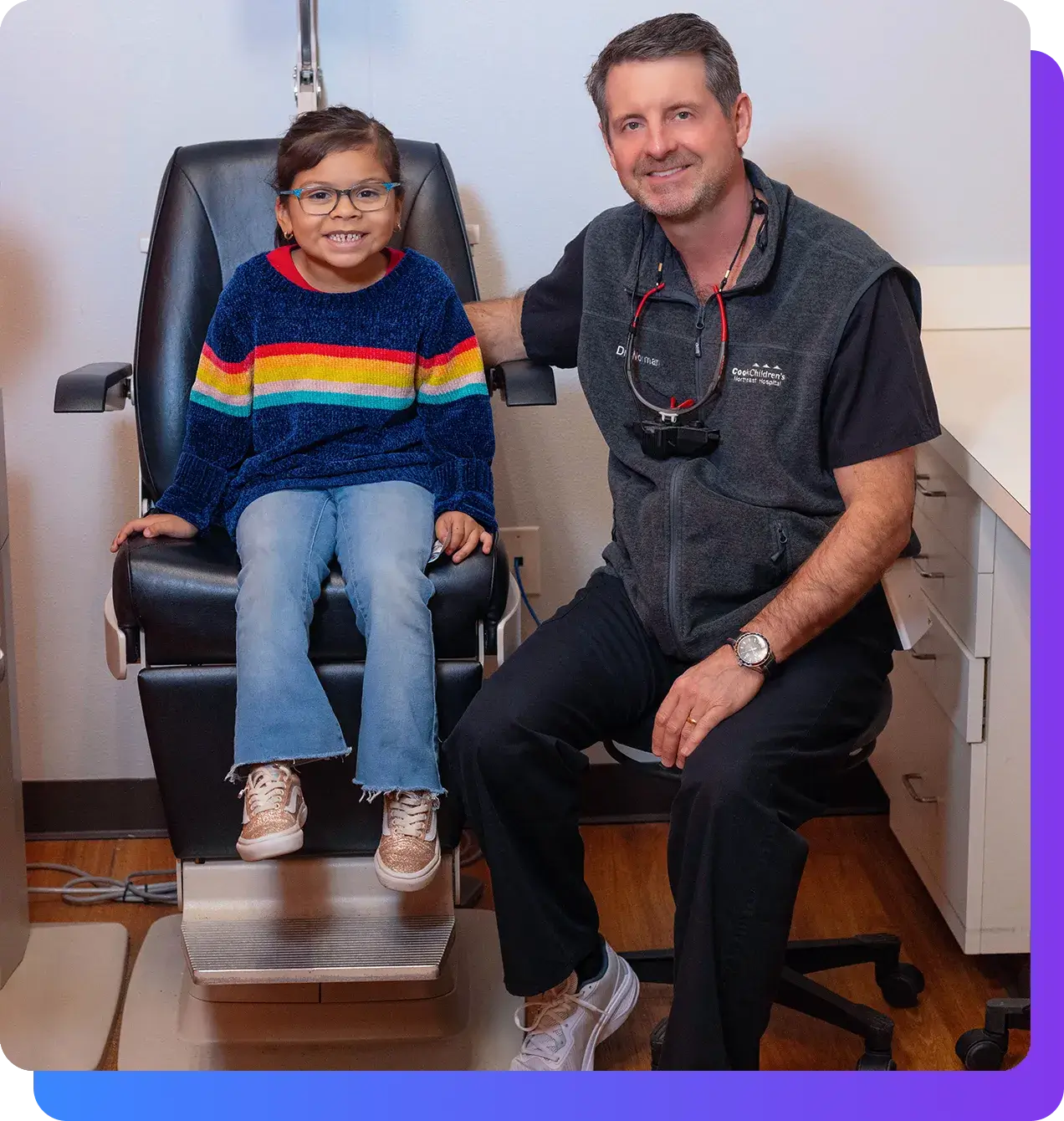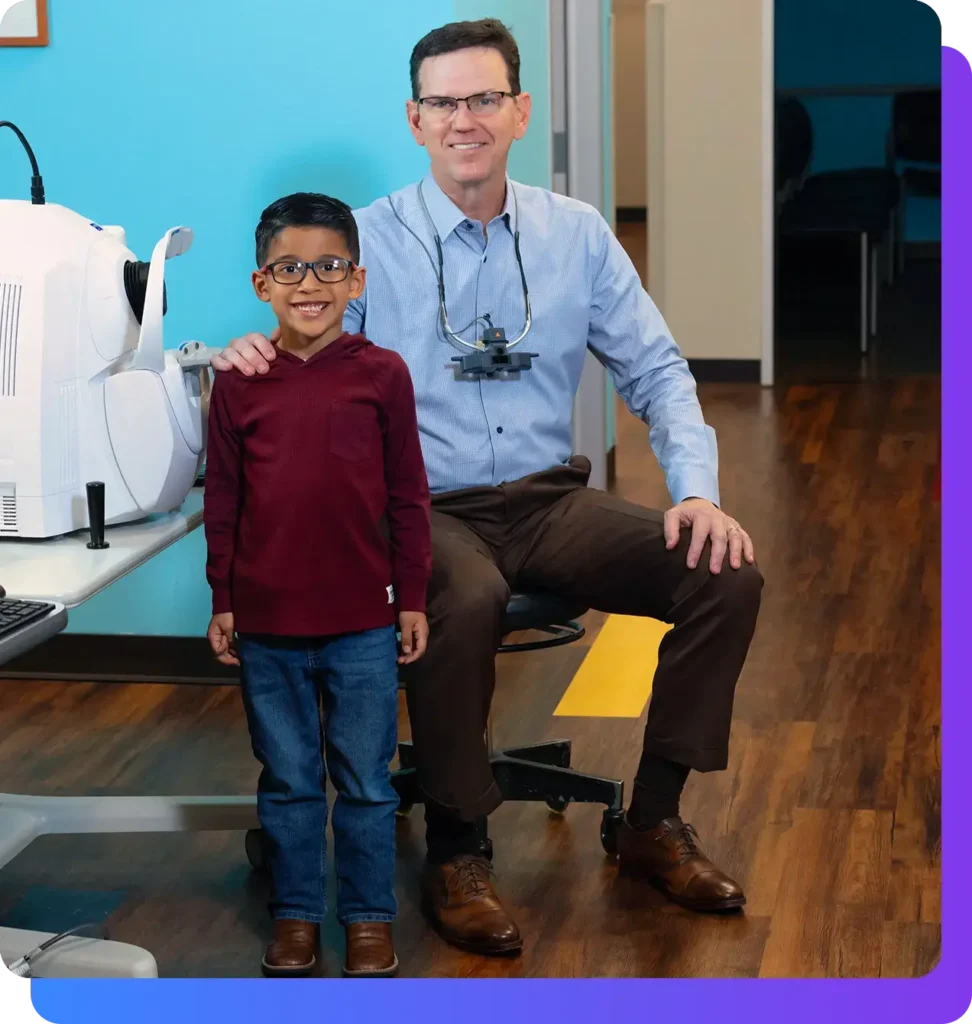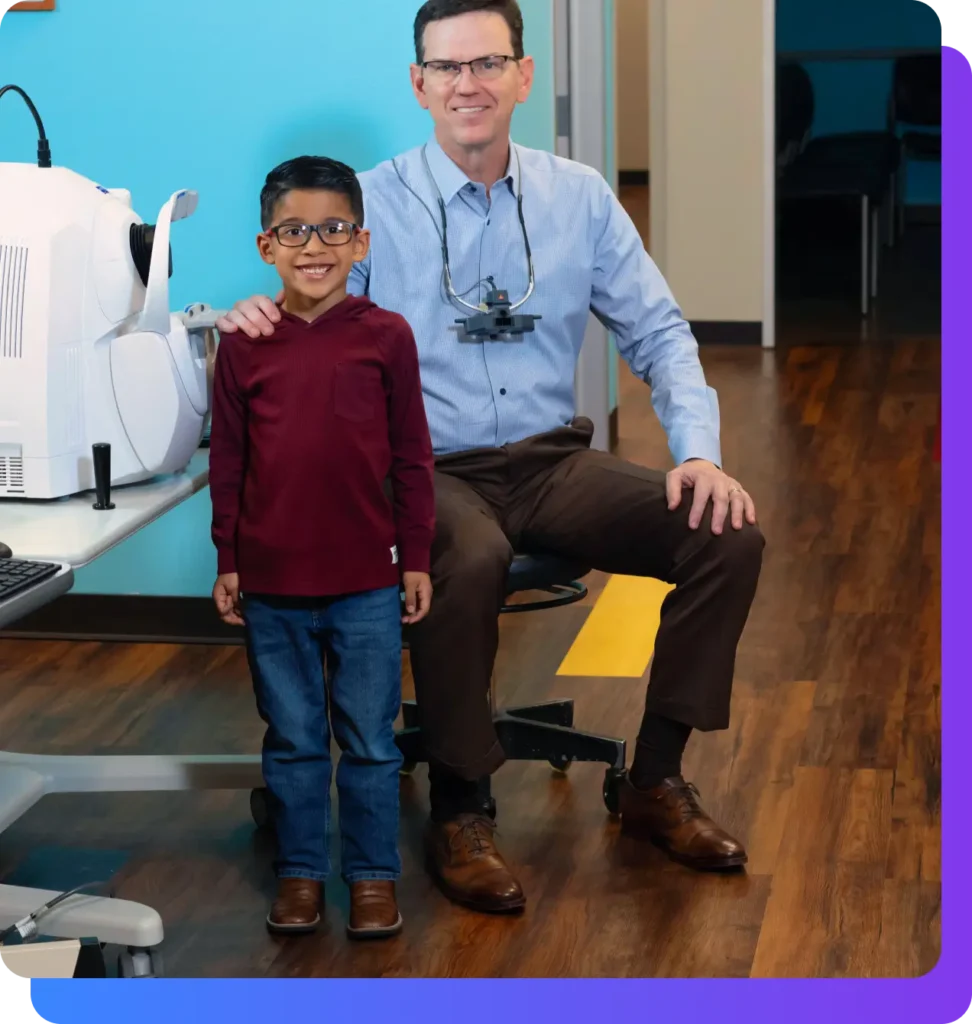Pediatric Nystagmus
Specialists in North Texas
Discovering that your child may have nystagmus can be a deeply unsettling experience. As parents, it’s natural to feel a mix of concern and uncertainty upon noticing unusual eye movements in your child.
Expert Pediatric Nystagmus Treatments for North Texas
At Pediatric Eye Specialists, we understand the emotional journey you are embarking on. Our dedicated team is here to provide not just answers, but also reassurance and support.
The early detection of nystagmus is vital. It opens the door to effective management and helps in mitigating any potential impacts on your child’s vision and development. Our specialists are committed to thorough, early diagnosis, ensuring that your child receives the care they need at the right time.

The Basics: What is Pediatric Nystagmus?
Pediatric nystagmus is a condition marked by involuntary, rhythmic eye movement that can affect one or both eyes in children. These movements can be horizontal, vertical, or even circular and often result from neurological or developmental issues. The erratic motion can cause a child’s vision to be shaky or blurry, potentially impacting their ability to focus clearly on objects. The intensity of nystagmus can vary, with some children experiencing mild movement that becomes pronounced when they are tired or stressed, while others may have constant and noticeable oscillations. Early and precise diagnosis is essential for managing the condition effectively, as it can influence a child’s visual development, learning, and daily activities.
Why Pediatric Eye Specialists for Pediatric Nystagmus
The Most Experienced Team in North Texas
With over sixty-five years of collective pediatric ophthalmology expertise, we offer your child unparalleled collaborative care.
Five Convenient Locations
Easily accessible care with offices in Fort Worth, Denton, Keller, Mansfield, and Prosper,
Unrushed, Clear Communication
We take the time to discuss your child's diagnosis and treatment, ensuring all your questions are answered to ease your concerns.
Affiliated with Cook Children’s Hospital
Our partnership with Cook Children’s Hospital means if your child needs surgery, imaging, or other specialists, they will be treated in one of the nation’s leading pediatric hospitals.
Specialized Expertise
Our expertise means that more optometrists, doctors, and specialists refer their pediatric eye patients to Pediatric Eye Specialists than any other pediatric eye practice in North Texas.
Child and Family Focused
Kids love us, and we love kids! We provide a caring environment for your child and your family.
Advanced Diagnostic Technology
We have the most comprehensive pediatric diagnostic suite in North Texas, allowing for precise diagnosis and highly personalized treatment plans.
Every Child Needs Access to Expert Eye Care
Championing the right to sight, we help navigate insurance, cash pay, and Medicaid options to make superior eye care feasible for all children regardless of their socioeconomic status.

Benefits of Treating Pediatric Nystagmus Early
It’s important to get your child’s nystagmus treated as early as possible: Early treatment can be a great advantage.
Success You Can Expect for Your Child
Enhanced Visual Development
Early treatment is key in ensuring the best possible visual outcomes for children with nystagmus. Timely intervention can significantly aid in visual development, leading to better vision in the long term.
Improved Quality of Life
Effective management of nystagmus can greatly enhance a child's day-to-day activities and learning experiences. It helps in reducing visual challenges, making daily tasks and educational activities more accessible.
Reduced Complications
Early treatment helps in preventing or mitigating secondary issues that are often associated with nystagmus, such as strabismus or amblyopia, contributing to better overall eye health.
Increased Confidence
Addressing nystagmus can have a positive impact on a child's social interactions and self-esteem. Children are often more confident and engaged when they experience improved visual function.
Educational Advantages
Early intervention supports academic performance by enabling necessary learning adaptations. This support is crucial for a child’s educational journey, especially in early schooling years.
Long-Term Eye Health
Ongoing management and regular checkups play a significant role in maintaining lifelong vision health, ensuring that any changes in the condition are addressed promptly.
Emotional Support for Families
Recognizing the emotional impact on families, treatment plans include support for parents and siblings, fostering a strong support system for the entire family.
Social Integration
Effective management of nystagmus facilitates smoother social interactions and participation in group activities, which is vital for a child's social development.
Independence in Daily Activities
With proper treatment, children with nystagmus gain more control over their visual abilities, leading to greater independence in their daily activities.
Real Stories,
Real Smiles.
“They were very good with my nonverbal toddler. It was the best doctor visit experience we have had yet. They were awesome, caring, and quick!.”

Amy Glover
Parent of Patient
“Today, Dr. Packwood saved my youngest from a life of blindness and worked a miracle for my family. I cannot express enough gratitude and thanks for their skillful surgery and expertise. 10 of 10 highly recommend.”

Atticus Lee
Parent of Patient
“The staff here is so amazing with my son. We had such a wonderful experience both at the office and for his surgery! I highly recommend Pediatric Eye Specialists!!!!“

Gianna Stutzman
Parent of Patient
“We are so grateful for the genuine care that Dr. Duff provided for our son Lorenzo, which prevented him from going blind! She is truly a gift to the community.“

JS Cocjin
Parent of Patient
“Professional, compassionate, kind and friendly. They took great care of my preemie baby from Day 1 of ROP. Very happy with how my daughter is progressing and has healthy eyes now.”

Suresh K.C.
Parent of Patient
“We’ve seen Dr. Hunt for the past 6 years since my daughter was 9 days old. We have multiple appointments each year and even eye surgery when she was 1. Our experience here has been fantastic every time and we highly recommend this group!.”

Mandy Edmondson
Parent of Patient
“Dr. Norman has always been very attentive and thorough with my daughter, who has Type 1 Diabetes. The staff are warm and always do their best to be accommodating. I highly recommend Dr. Norman.”

Tricia Moon
Parent of Patient
“Absolutely recommend! All around great experience! They made my son feel comfortable during the visit. Treatment was explained, and I walked out with no questions. I loved it. “

Cynthia Valero
Parent of Patient
“Great staff, great doctors; they know how to help ease kids’ fears and provide excellent service. Had to get my little one in same day for an eye injury, and they found a way to make it happen. Would 100% recommend.“

Kris K
Parent of Patient
Start your child’s journey to better vision today.
Embrace a future of clearer vision and confidence for your child. Contact us now to book your consultation at any of our convenient locations across the Metroplex.
Click to Explore Pediatric Nystagmus
Causes of Pediatric Nystagmus
As parents, learning that your child has nystagmus can be concerning. Understanding the causes of this condition is a crucial step in managing it effectively. In medicine, we call this etiology. Here’s what you need to know:
Genetic Factors
Nystagmus often has a genetic basis. Conditions like albinism, characterized by reduced melanin production, frequently present with nystagmus. Similarly, optic nerve hypoplasia, where the optic nerve is underdeveloped, can lead to nystagmus.
Neurological Factors
Neurological issues affecting the control of eye movements can result in nystagmus. This includes conditions that impact the brain or the nerve pathways responsible for eye muscle coordination.
Associated Conditions
Nystagmus is sometimes linked with other syndromes and diseases, such as congenital cataracts or Leber congenital amaurosis. These conditions disrupt normal visual development, leading to the development of nystagmus.
Birth Defects
Developmental issues during pregnancy can result in birth defects that affect the eyes or the overall visual system, leading to nystagmus.
Idiopathic Causes
In some children, the cause of nystagmus is idiopathic, meaning it appears without a known reason. This type is often referred to as idiopathic infantile or congenital nystagmus and is diagnosed when other causes are ruled out.
Understanding these causes helps in guiding the appropriate diagnostic and treatment.
Understanding these causes is vital for Pediatric Eye Specialists in diagnosing and formulating an effective treatment plan for nystagmus.
Signs and Symptoms of Pediatric Nystagmus
Parents may notice some “dancing” or “jittery movements” in their child’s eyes. Here are additional signs your child might have nystagmus:
Involuntary Eye Movement
The most noticeable symptom of nystagmus is the involuntary, rhythmic oscillation of the eyes. This can manifest as horizontal, vertical, or rotary movements.
Visual Impairment
Children with nystagmus may experience blurred vision or reduced visual acuity, impacting their ability to see clearly.
Head Tilting or Turning
To achieve better visual focus, children with nystagmus might adopt unusual head postures, such as tilting or turning their heads to a specific position.
Photophobia
Sensitivity to light, or photophobia, is a common symptom in children with nystagmus, especially in cases associated with albinism.
Difficulty with Depth Perception
Nystagmus can affect a child’s ability to perceive depth accurately, which may impact activities like catching a ball or climbing stairs.
Challenges with Distance Vision
Children with nystagmus might struggle to see objects at a distance, affecting activities such as reading the board in a classroom setting.
Oscillopsia
Some children with nystagmus experience oscillopsia, a condition where the world appears to be in constant motion due to the eye movements.
We often here parents say things like:
- “His eyes make repetitive, jerking movements I’ve never noticed before.”
- “When she tries to focus on something, her eyes flutter and dance around.”
- “His eyes seem to shake involuntarily, especially when tired or zoning out.”
Still Have Questions?
Discovering your child may have nystagmus can be daunting. You likely have many questions about what this means for their future and how it can be managed. At Pediatric Eye Specialists, we’re here to provide the information and support you need. We encourage you to ask questions and access our resources to better understand your child’s condition and the available treatments. Our goal is to ensure you feel informed and supported as we work together to optimize your child’s visual potential. Don’t hesitate to reach out with any concerns; our team is dedicated to helping you every step of the way.
Diagnosing Pediatric Nystagmus
There are three movement types of nystagmus your physician will be diagnosing as he or she observes your child:
Horizontal Nystagmus
Horizontal nystagmus is the most common type. Eye movements are side to side. This movement can be a sign of either a congenital condition (present from birth) or an acquired condition (developed later due to various factors, such as inner ear problems, medication side effects, or neurological issues).
Vertical Nystagmus
Vertical nystagmus is less common than horizontal nystagmus. Eye movements go up and down. This movement often indicates a problem with the central nervous system and can be associated with more serious conditions. It might be seen in disorders affecting the brainstem or cerebellum, or as a result of certain medications or toxins.
Rotary Nystagmus
This type of nystagmus looks like eyes are slowly tracing a circle or ellipse shape when someone with this condition tries to focus gaze on an object. Rotary nystagmus is typically caused by a problem with the vestibular system (the part of the inner ear responsible for balance and position).
The underlying causes of the three can differ significantly, and so can their clinical significance. Horizontal nystagmus might sometimes be considered less alarming, especially if it is congenital and isolated (without other neurological symptoms). On the other hand, vertical and rotary nystagmus are more likely to be signs of a central nervous system disorder and are generally considered more unusual and potentially more serious.
Diagnosing the exact type and cause of nystagmus requires a detailed medical evaluation by a healthcare professional, often involving a neurologist or an ophthalmologist.
Diagnostic Steps
Understanding how pediatric nystagmus is diagnosed can be a vital part of the journey towards managing your child’s condition effectively. Here’s a closer look at the diagnostic steps:
Initial Eye Examinations
The journey begins with a comprehensive eye examination at Pediatric Eye Specialists. Our focus is on evaluating your child’s involuntary eye movements, visual acuity, and eye alignment.
Medical History Review
A thorough medical history is essential. This encompasses any family history of nystagmus, birth history, and developmental milestones, particularly those related to vision.
Observation of Eye Movements
Our ophthalmologists carefully observe the characteristics of the eye movements—their direction, amplitude, frequency, and triggers. This observation is key in identifying nystagmus patterns.
Specialized Equipment Utilization
Tools like slit lamps and ophthalmoscopes allow for a detailed examination of the eye’s structures, aiding in the assessment of nystagmus.
Medical Imaging
In certain cases, advanced imaging such as MRI or OCT is used to uncover or rule out underlying causes, whether neurological or structural.
Electrophysiological Tests
ERG and VEP tests might be conducted to evaluate retinal and optic nerve function, especially in suspected cases of conditions like Leber’s congenital amaurosis.
Referrals to Specialists
If necessary, your child may be referred to neurologists or geneticists for a more comprehensive evaluation, particularly if the nystagmus is part of a broader condition.
Ongoing Monitoring
Diagnosing pediatric nystagmus is a continuous process. Regular checkups are essential to monitor the progression and impact of nystagmus on your child’s vision and overall development.
Treatments for Nystagmus in Children
Navigating the treatment options for pediatric nystagmus can be overwhelming, but understanding these choices is crucial for your child’s visual health. Here’s an overview of the treatment modalities we offer at Pediatric Eye Specialists:
Corrective Lenses
Glasses or contact lenses can significantly improve clarity of vision for children with nystagmus; these lenses are particularly effective in addressing common refractive errors such as nearsightedness and astigmatism that often accompany nystagmus.
Prism Lenses
These specialized lenses that bend light can help to reduce the characteristic head tilting or turning associated with nystagmus, thereby enhancing the child’s ability to focus and engage more comfortably with their environment.
Pharmacological Options
Medications like gabapentin or baclofen can reduce the severity of nystagmus, potentially improving the child’s focus and ability to perform tasks that require visual precision.
Surgery
Surgical interventions aim to realign the eyes to a position where nystagmus is minimized, which can significantly improve visual function and reduce any associated abnormal head postures.
Eye Muscle Surgery
This type of surgery is particularly beneficial for children whose nystagmus is linked to an underlying eye muscle imbalance or strabismus, offering a more stable visual field.
Botulinum Toxin Injections
Used judiciously, these injections can temporarily adjust the eye muscle dynamics, which may result in a period of improved visual stability and reduced nystagmus.
Management of Associated Conditions
Treating conditions like cataracts, which can co-occur with nystagmus, often results in a marked improvement in the child’s overall vision and may reduce the intensity of nystagmus.
Regular Monitoring
Continuous observation and adjustment of treatment plans are vital as nystagmus can evolve with the child’s growth and development. Regular monitoring will ensure the most effective care tailored to their changing needs.
In each of these treatment avenues at Pediatric Eye Specialists, we emphasize a personalized approach, understanding that every child’s experience with nystagmus is unique. Our goal is to ensure that every child achieves the best possible visual outcome.
Our commitment at Pediatric Eye Specialists is to provide your child with the highest standard of care, combining medical expertise with compassion and understanding.
Living with Pediatric Nystagmus: Navigating Daily Life and Long-Term Care
As parents of a child with pediatric nystagmus, it’s natural to seek ways to make daily life smoother and more comfortable for your child. Here are some practical tips and strategies:
1. Create a Supportive Environment
Encourage an atmosphere of positivity and resilience. Celebrate small victories and progress, and reassure your child that they can lead a fulfilling life despite their condition.
2. Optimize Home and School Settings
Ensure good lighting and minimal visual distractions at home and in school. Work with teachers to position your child in the classroom where they can see best and provide them with assistive devices or materials as needed.
3. Encourage Regular Eye Checkups
Consistent monitoring of your child’s vision is crucial. Regular visits to Pediatric Eye Specialists will help track changes in your child’s condition and adjust treatments as necessary.
4. Promote Independence
Teach your child to express when they are experiencing visual difficulties and advocate for themselves. This fosters independence and self-reliance, critical for their self-esteem.
5. Engage in Eye-Friendly Activities
Encourage activities that don’t strain the eyes. Activities like audio books, storytelling, or tactile games can be enjoyable and less visually demanding.
6. Educational Support
Collaborate with your child’s school to implement special education services if needed. This might include individualized education plans (IEPs) or 504 plans to accommodate their learning needs.
7. Build a Support Network
Connect with other families dealing with pediatric nystagmus. Support groups, both in-person and online, can offer valuable advice, empathy, and a sense of community.
8. Focus on Overall Wellbeing
Beyond visual health, ensure your child’s emotional and psychological needs are addressed. If needed, seek support from counselors or therapists who specialize in helping children with chronic conditions.
9. Stay Informed
Keep abreast of the latest research and advancements in nystagmus treatment. This knowledge can empower you to make informed decisions about your child’s care.
Living with pediatric nystagmus requires patience, understanding, and proactive management. By adopting these strategies and working closely with healthcare professionals, you can help your child navigate their world with confidence and positivity.
Secure a Brighter Future: Schedule Your Child's Nystagmus Consultation Today
As a parent, facing concerns about your child’s eye health can be daunting, but you’re not alone. At Pediatric Eye Specialists, we understand the anxiety and uncertainty that comes with noticing something unusual like a dermoid cyst. Let us offer you peace of mind and expert care. Schedule an appointment today, and take the first step towards ensuring your child receives the attentive and specialized treatment they need. Together, we can safeguard your child’s vision and well-being.

Start your child’s journey to better vision today.
Embrace a future of clearer vision and confidence for your child. Contact us now to book your consultation at any of our convenient locations across the Metroplex.
What is pediatric nystagmus?
Pediatric nystagmus is a condition where a child’s eyes move rapidly and uncontrollably. It can look like the eyes are shaking or wobbling.
Why does my child have nystagmus?
Nystagmus in children can happen for various reasons. It might be something they were born with, or it could be related to another eye or medical condition.
Can nystagmus be cured?
There’s no outright cure for nystagmus, but there are treatments that can help manage it and improve vision.
Will my child outgrow nystagmus?
Nystagmus usually doesn’t go away on its own. However, its impact can be lessened with proper treatment and care.
How is nystagmus diagnosed?
Doctors usually diagnose nystagmus with a thorough eye exam. They might also use special tests to look at how the eyes move and to check the health of the eyes and nerves.
Is nystagmus common in children?
Nystagmus isn’t very common, but it’s not extremely rare either. Many children with nystagmus lead normal lives with proper care.
Does nystagmus affect how my child sees?
Nystagmus can make vision blurry or wobbly, which might affect how your child reads or plays. Some children may need extra support in school.
What treatments are available for nystagmus?
Treatments can include glasses, contact lenses, or even surgery, depending on the child’s condition. Sometimes specific medications are also used.
Can my child play sports with nystagmus?
Many children with nystagmus can play sports. It’s important to find activities that your child enjoys and feels comfortable doing.
How can I help my child with nystagmus?
You can help by ensuring they attend their eye appointments, follow the doctor’s advice, and by providing them with a supportive and understanding environment at home and school.
What strategies can help my child with sensory defect nystagmus engage more effectively in their environment?
Children with sensory defect nystagmus may benefit from using assistive visual tools and approaches, such as using high-contrast colors and adequate lighting, to improve visual engagement
How does nystagmus affect my infant’s visual perception?
Nystagmus can cause the vision to be shaky or unstable, which might make it challenging for your infant to focus on objects, potentially impacting their ability to perceive the world as stable and clear.
How can nystagmus impact my child’s everyday life, and what adjustments might we need to make?
Nystagmus can affect visual focus, so your child may need accommodations like large-print materials and preferential seating to aid learning and daily activities.
Is nystagmus linked to broader neurological issues?
Yes, nystagmus can sometimes be associated with neurological conditions since it involves the parts of the brain that control eye movements.
Can nystagmus indicate an underlying issue with the retina?
Nystagmus doesn’t directly affect the retina, but it can sometimes be a symptom of conditions that do.
Should we consider genetic counseling for inherited nystagmus?
Yes, genetic counseling can be helpful, especially if there’s a family history of nystagmus, to understand any inherited genetic components.
Will my child need to see different physicians for nystagmus management?
Managing nystagmus often involves a team of healthcare providers, including pediatric ophthalmologists, neurologists, and sometimes geneticists.
How does achromatopsia relate to nystagmus?
Achromatopsia, which is a condition where the individual can’t see color, often comes with nystagmus because both can be symptoms of abnormal visual development.
Can nystagmus be an early indicator of aniridia?
Aniridia, the absence of the iris, is sometimes associated with nystagmus, as both can result from congenital anomalies affecting the eye.
Could the nystagmus in my child be related to blood circulation issues?
While nystagmus is usually not directly caused by blood circulation problems, conditions that affect blood flow to the brain, like a stroke, can sometimes result in nystagmus.
What is the role of coloboma in the development of nystagmus?
A coloboma is a gap in part of the eye’s structure, like the iris, which can disrupt normal vision and potentially lead to nystagmus.
How do afferent nerve fibers impact nystagmus?
Afferent nerve fibers transmit visual information from the eyes to the brain. If there’s a problem with these nerves, it can disrupt visual processing and contribute to nystagmus.
How does the optokinetic response differ in children with nystagmus?
In nystagmus, the optokinetic response, which is a reflex that helps the eye track moving objects, may be impaired, leading to difficulties with tracking and stability of vision.
What characterizes pendular nystagmus in infants?
Pendular nystagmus involves smooth, back-and-forth eye movements that are equal in speed in both directions, and it can be observed early in infants.
How will nystagmus affect my child’s development of binocular vision?
Nystagmus can make it harder for the eyes to align correctly, which can disrupt the development of binocular vision, or the ability to use both eyes together effectively.
How does fixation ability change in a child with infantile nystagmus syndrome?
In infantile nystagmus syndrome, children may develop a head posture that allows them to use their gaze to find a “null point” where the nystagmus is less and fixation is better.
Can retinopathy of prematurity cause nystagmus, and if so, how is it managed?
Yes, retinopathy of prematurity can lead to visual impairments like nystagmus. Retinopathy of prematurity occurs when a premature infant’s blood vessels and nerves grow abnormally. Management may include drugs to control the eye movements and therapies to improve visual function.
Does the cerebellum play a role in the development or treatment of nystagmus?
The cerebellum, which coordinates movement, can be involved in nystagmus. Treatments may target the neurological basis of nystagmus to improve eye movement control.
Can problems in the cerebral cortex contribute to nystagmus?
Yes, since the cerebral cortex is involved in processing visual information, any developmental issues here, like those associated with cerebral palsy, can contribute to nystagmus.
Is there a link between preterm birth and the development of nystagmus?
Preterm birth can be a risk factor for several conditions, including retinopathy of prematurity, which can lead to nystagmus.
How does congenital stationary night blindness affect nystagmus?
Congenital stationary night blindness is a condition that can present with nystagmus due to a sensory defect in the retina, affecting how visual information is processed.
What is latent nystagmus, and how is it different from other forms?
Latent nystagmus is a condition that typically only becomes apparent when one eye is covered and is often associated with conditions like strabismus.
What does the nystagmus waveform reveal about my child’s condition?
Analyzing the nystagmus waveform involves looking at the eye velocity, frequency, amplitude and periodicity of the involuntary oscillations (movements). This allows ophthalmologists and neurologists to characterize the type of nystagmus more specifically (e.g. horizontal, vertical, pendular, jerk, bidirectional). The waveform essentially creates a visual map of the abnormal eye movements over time, helping pinpoint where dysfunction is occurring in the vestibular (inner ear) or ocular motor (neurological) systems regulating gaze and balance.